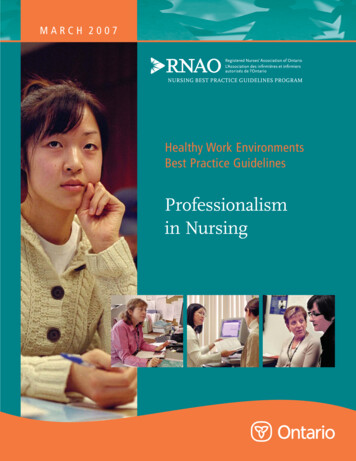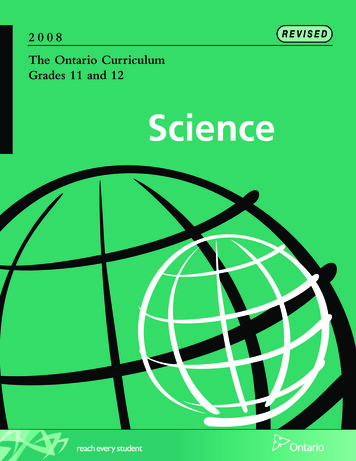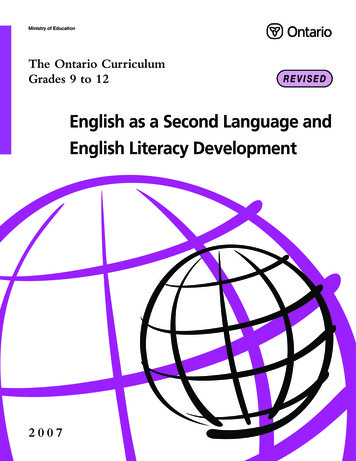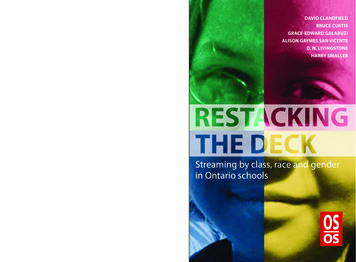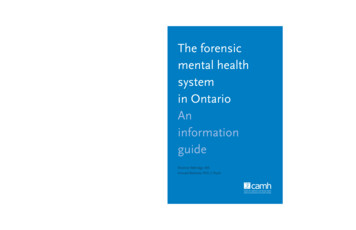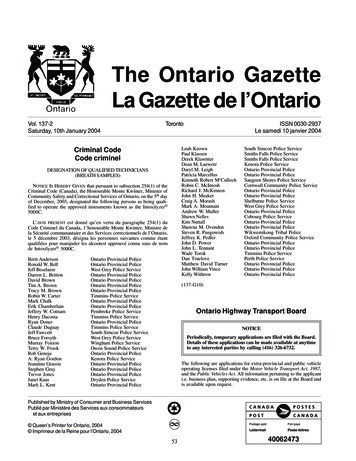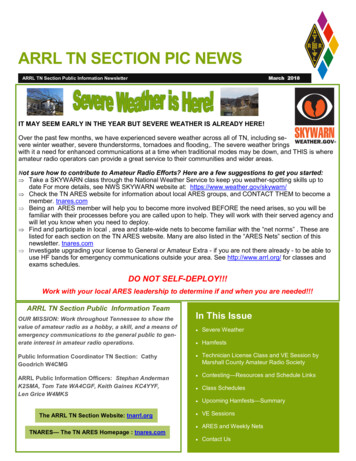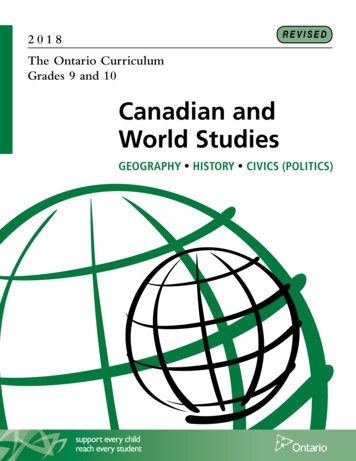
Transcription
REVISED2018The Ontario CurriculumGrades 9 and 10Canadian andWorld StudiesGEOGRAPHY HISTORY CIVICS (POLITICS)
The Ontario Public Service endeavours to demonstrate leadership with respect to accessibilityin Ontario. Our goal is to ensure that Ontario government services, products, and facilities areaccessible to all our employees and to all members of the public we serve. This document, orthe information that it contains, is available, on request, in alternative formats. Please forwardall requests for alternative formats to ServiceOntario at 1-800-668-9938 (TTY: 1-800-268-7095).
CONTENTSPREFACE3Secondary Schools for the Twenty-First Century . . . . . . . . . . . . . . . . . . . . . . . . . . . . . . . . . . . . . . 3Supporting Students’ Well-Being and Ability to Learn. . . . . . . . . . . . . . . . . . . . . . . . . . . . . . . . . 3INTRODUCTION6The Vision and Goals of the Canadian and World Studies Curriculum . . . . . . . . . . . . . . . . . . 6The Importance of the Canadian and World Studies Curriculum . . . . . . . . . . . . . . . . . . . . . . . 9The Citizenship Education Framework . . . . . . . . . . . . . . . . . . . . . . . . . . . . . . . . . . . . . . . . . . . 10Geography . . . . . . . . . . . . . . . . . . . . . . . . . . . . . . . . . . . . . . . . . . . . . . . . . . . . . . . . . . . . . . . . . . . . . . . . . 10History . . . . . . . . . . . . . . . . . . . . . . . . . . . . . . . . . . . . . . . . . . . . . . . . . . . . . . . . . . . . . . . . . . . . . . . . . . . . . 11Civics (Politics) . . . . . . . . . . . . . . . . . . . . . . . . . . . . . . . . . . . . . . . . . . . . . . . . . . . . . . . . . . . . . . . . . . . . . 12Concepts Underlying the Canadian and World Studies Curriculum . . . . . . . . . . . . . . . . . . . 13Indigenous Education in Ontario . . . . . . . . . . . . . . . . . . . . . . . . . . . . . . . . . . . . . . . . . . . . . . . . . . . . 15Roles and Responsibilities in the Canadian and World Studies Program . . . . . . . . . . . . . . 16THE PROGRAM IN CANADIAN AND WORLD STUDIESOverview of the Program . . . . . . . . . . . . . . . . . . . . . . . . . . . . . . . . . . . . . . . . . . . . . . . . . . . . . . . . . . .Curriculum Expectations . . . . . . . . . . . . . . . . . . . . . . . . . . . . . . . . . . . . . . . . . . . . . . . . . . . . . . . . . . . .Strands in the Canadian and World Studies Curriculum . . . . . . . . . . . . . . . . . . . . . . . . . . . . . .The Inquiry Process . . . . . . . . . . . . . . . . . . . . . . . . . . . . . . . . . . . . . . . . . . . . . . . . . . . . . . . . . . . . .Spatial Skills: Using Maps, Globes, and Graphs . . . . . . . . . . . . . . . . . . . . . . . . . . . . . . . . . . . . . . .ASSESSMENT AND EVALUATION OF STUDENT ACHIEVEMENT19192427282930Basic Considerations. . . . . . . . . . . . . . . . . . . . . . . . . . . . . . . . . . . . . . . . . . . . . . . . . . . . . . . . . . . . . . . . 30The Achievement Chart for Canadian and World Studies . . . . . . . . . . . . . . . . . . . . . . . . . . . . . 33SOME CONSIDERATIONS FOR PROGRAM PLANNING IN CANADIANAND WORLD STUDIESInstructional Approaches . . . . . . . . . . . . . . . . . . . . . . . . . . . . . . . . . . . . . . . . . . . . . . . . . . . . . . . . . . .Planning Canadian and World Studies Programs for Students withSpecial Education Needs . . . . . . . . . . . . . . . . . . . . . . . . . . . . . . . . . . . . . . . . . . . . . . . . . . . . . . . . . . . .Program Considerations for English Language Learners . . . . . . . . . . . . . . . . . . . . . . . . . . . . .Environmental Education and Canadian and World Studies . . . . . . . . . . . . . . . . . . . . . . . . . .Une publication équivalente est disponible en français sous le titresuivant : Le curriculum de l’Ontario – 9e et 10e année – Études canadienneset mondiales, 2018This publications is available on the Ministry of Education website,at www.ontario.ca/edu3838404346
Healthy Relationships and Canadian and World Studies. . . . . . . . . . . . . . . . . . . . . . . . . . . . . .Equity and Inclusive Education in the Canadian and World Studies Program . . . . . . . . . .Financial Literacy in Canadian and World Studies . . . . . . . . . . . . . . . . . . . . . . . . . . . . . . . . . . . .Literacy, Mathematical Literacy, and Inquiry Skills in Canadian and World Studies . . . .Critical Thinking and Critical Literacy in Canadian and World Studies . . . . . . . . . . . . . . . . .The Role of the School Library in the Canadian and World Studies Program. . . . . . . . . . .The Role of Information and Communications Technology in the Canadianand World Studies Program . . . . . . . . . . . . . . . . . . . . . . . . . . . . . . . . . . . . . . . . . . . . . . . . . . . . . . . . .The Ontario Skills Passport: Making Learning Relevant and Building Skills . . . . . . . . . . . .Education and Career/Life Planning through the Canadian and WorldStudies Curriculum . . . . . . . . . . . . . . . . . . . . . . . . . . . . . . . . . . . . . . . . . . . . . . . . . . . . . . . . . . . . . . . . .Cooperative Education and Other Forms of Experiential Learning . . . . . . . . . . . . . . . . . . . .Planning Program Pathways and Programs Leading to a Specialist High Skills Major . . . .Health and Safety in the Canadian and World Studies Program. . . . . . . . . . . . . . . . . . . . . . .Ethics in the Canadian and World Studies Program . . . . . . . . . . . . . . . . . . . . . . . . . . . . . . . . . roduction . . . . . . . . . . . . . . . . . . . . . . . . . . . . . . . . . . . . . . . . . . . . . . . . . . . . . . . . . . . . . . . . . . . . . . .Strands. . . . . . . . . . . . . . . . . . . . . . . . . . . . . . . . . . . . . . . . . . . . . . . . . . . . . . . . . . . . . . . . . . . . . . . .The Concepts of Geographic Thinking . . . . . . . . . . . . . . . . . . . . . . . . . . . . . . . . . . . . . . . . . . .The Geographic Inquiry Process . . . . . . . . . . . . . . . . . . . . . . . . . . . . . . . . . . . . . . . . . . . . . . . . .Issues in Canadian Geography, Grade 9, Academic (CGC1D). . . . . . . . . . . . . . . . . . . . . . . . . .Issues in Canadian Geography, Grade 9, Applied (CGC1P) . . . . . . . . . . . . . . . . . . . . . . . . . . . .HISTORYIntroduction . . . . . . . . . . . . . . . . . . . . . . . . . . . . . . . . . . . . . . . . . . . . . . . . . . . . . . . . . . . . . . . . . . . . .Strands. . . . . . . . . . . . . . . . . . . . . . . . . . . . . . . . . . . . . . . . . . . . . . . . . . . . . . . . . . . . . . . . . . . . . .The Concepts of Historical Thinking . . . . . . . . . . . . . . . . . . . . . . . . . . . . . . . . . . . . . . . . . . . .The Historical Inquiry Process . . . . . . . . . . . . . . . . . . . . . . . . . . . . . . . . . . . . . . . . . . . . . . . . .Canadian History since World War I, Grade 10, Academic (CHC2D). . . . . . . . . . . . . . . . . .Canadian History since World War I, Grade 10, Applied (CHC2P) . . . . . . . . . . . . . . . . . . . .CIVICS (POLITICS)Introduction . . . . . . . . . . . . . . . . . . . . . . . . . . . . . . . . . . . . . . . . . . . . . . . . . . . . . . . . . . . . . . . . . . . . .Strands. . . . . . . . . . . . . . . . . . . . . . . . . . . . . . . . . . . . . . . . . . . . . . . . . . . . . . . . . . . . . . . . . . . . . .The Concepts of Political Thinking . . . . . . . . . . . . . . . . . . . . . . . . . . . . . . . . . . . . . . . . . . . . .The Political Inquiry Process . . . . . . . . . . . . . . . . . . . . . . . . . . . . . . . . . . . . . . . . . . . . . . . . . . .Civics and Citizenship, Grade 10, Open (CHV2O) . . . . . . . . . . . . . . . . . . . . . . . . . . . . . . . . . . 55APPENDICESA. The Goals of Social Studies, Economics, and Law . . . . . . . . . . . . . . . . . . . . . . . . . . . . . . . . 167B. The Citizenship Education Framework (table) . . . . . . . . . . . . . . . . . . . . . . . . . . . . . . . . . . . 169C. Map, Globe, and Graphing Skills – A Continuum . . . . . . . . . . . . . . . . . . . . . . . . . . . . . . . . . 171GLOSSARY2179
PREFACEThis document replaces The Ontario Curriculum, Grades 9 and 10: Canadian and WorldStudies, 2013. Beginning in September 2018, all Canadian and world studies coursesfor Grades 9 and 10 will be based on the expectations outlined in this document.This edition of the curriculum includes a revision of the history curriculum,1 developedin collaboration with First Nations, Métis, and Inuit educators, community members, andorganizations. The revision was undertaken in response to the Truth and ReconciliationCommission of Canada’s calls to action numbers 62 and 63.SECONDARY SCHOOLS FOR THE TWENTY-FIRST CENTURYThe goal of Ontario secondary schools is to support high-quality learning while givingindividual students the opportunity to choose programs that suit their skills and interests.The updated Ontario curriculum, in combination with a broader range of learning optionsoutside traditional classroom instruction, will enable students to better customize theirhigh school education and improve their prospects for success in school and in life.The revised curriculum recognizes that, today and in the future, students need to becritically literate in order to synthesize information, make informed decisions, communicateeffectively, and thrive in an ever-changing global community. It is important that studentsbe connected to the curriculum; that they see themselves in what is taught, how it is taught,and how it applies to the world at large. The curriculum recognizes that the needs oflearners are diverse, and helps all learners develop the knowledge, skills, and perspectivesthey need to be informed, productive, caring, responsible, healthy, and active citizens intheir own communities and in the world.SUPPORTING STUDENTS’ WELL-BEING AND ABILITY TO LEARNPromoting the healthy development of all students, as well as enabling all students toreach their full potential, is a priority for educators across Ontario. Students’ health andwell-being contribute to their ability to learn in all disciplines, including Canadian andworld studies, and that learning in turn contributes to their overall well-being.Educators play an important role in promoting children and youth’s well-being by creating,fostering, and sustaining a learning environment that is healthy, caring, safe, inclusive,and accepting. A learning environment of this kind will support not only students’ cognitive,emotional, social, and physical development but also their sense of self and spirit, theirmental health, their resilience, and their overall state of well-being. All this will help themachieve their full potential in school and in life.1. This revision focused only on the two history courses. Consequently, there may be differences in terminologyand style between the revised courses and the balance of the document.3
A variety of factors, known as the “determinants of health”, have been shown to affecta person’s overall state of well-being. Some of these are income, education and literacy,gender and culture, physical and social environment, personal health practices andcoping skills, and availability of health services. Together, such factors influence notonly whether individuals are physically healthy but also the extent to which they willhave the physical, social, and personal resources needed to cope and to identify andachieve personal aspirations. These factors also have an impact on student learning, andit is important to be aware of them as factors contributing to a student’s performanceand well-being.An educator’s awareness of and responsiveness to students’ cognitive, emotional, social,and physical development, and to their sense of self and spirit, is critical to their successin school. A number of research-based frameworks, including those described in EarlyLearning for Every Child Today: A Framework for Ontario Early Childhood Settings (2007),On My Way: A Guide to Support Middle Years Child Development (2017), and SteppingStones: A Resource on Youth Development (2012),2 identify developmental stages that arecommon to the majority of students from Kindergarten to Grade 12. At the same time,these frameworks recognize that individual differences, as well as differences in lifeexperiences and exposure to opportunities, can affect development, and that developmental events are not specifically age-dependent.THE ONTARIO CURRICULUM, GRADES 9 AND 10 Canadian and World StudiesThe framework described in Stepping Stones is based on a model that illustrates thecomplexity of human development. Its components – the cognitive, emotional, physical,and social domains – are interrelated and interdependent, and all are subject to theinfluence of a person’s environment or context. At the centre is an “enduring (yet changing)core” – a sense of self, or spirit – that connects the different aspects of development andexperience (p. 17).4Source: Stepping Stones: A Resource on Youth Development, p. 172. Best Start Expert Panel on Early Learning, Early Learning for Every Child Today: A Framework for Ontario EarlyChildhood Settings (2007) is available at um.pdf; Ministryof Children and Youth Services, On My Way: A Guide to Support Middle Years Child Development (2017) is availableat s/middleyears/onmyway/index.aspx; and Governmentof Ontario, Stepping Stones: A Resource on Youth Development (2012) is available at .
Educators who have an awareness of a student’s development take each component intoaccount, with an understanding of and focus on the following elements: cognitive development – brain development, processing and reasoning skills, useof strategies for learning emotional development – emotional regulation, empathy, motivation social development – self-development (self-concept, self-efficacy, self-esteem);identity formation (gender identity, social group identity, spiritual identity);relationships (peer, family, romantic) physical development – physical activity, sleep patterns, changes that come withpuberty, body image, nutritional requirementsThe Role of Mental HealthMental health touches all components of development. Mental health is much morethan the absence of mental illness. Well-being is influenced not only by the absence ofproblems and risks but by the presence of factors that contribute to healthy growth anddevelopment. By nurturing and supporting students’ strengths and assets, educatorshelp promote positive mental health in the classroom. At the same time, they can identifystudents who need additional support and connect them with the appropriate services.3What happens at school can have a significant influence on a student’s well-being.With a broader awareness of mental health, educators can plan instructional strategiesthat contribute to a supportive classroom climate for learning in all subject areas, buildawareness of mental health, and reduce stigma associated with mental illness. Takingstudents’ well-being, including their mental health, into account when planning instructionalapproaches helps establish a strong foundation for learning.PREFACE3. See the ministry document Supporting Minds: An Educator’s Guide to Promoting Students’ Mental Health andWell-being (2013).5
INTRODUCTIONTHE VISION AND GOALS OF THE CANADIAN AND WORLD STUDIES CURRICULUMThe Grade 9 to 12 Canadian and world studies curriculum shares a common vision withthe Grade 1 to 8 social studies, history, and geography curriculum. That vision and thegoals of the elementary and secondary program are as follows:Vision and Goals for Social Studies, Grades 1 to 6; History and Geography, Grades 7 and 8; andCanadian and World Studies, Grades 9 to 12VisionThe social studies, history, geography, and Canadian and world studies programs will enable studentsto become responsible, active citizens within the diverse communities to which they belong. As wellas becoming critically thoughtful and informed citizens who value an inclusive society, students willhave the skills they need to solve problems and communicate ideas and decisions about significantdevelopments, events, and issues.GoalsIn social studies, history, and geography, and all the subjects in Canadian and world studies, studentsrealize the vision for the program as they: develop the ability to use the “concepts of disciplinary thinking” to investigate issues, events, anddevelopments; develop the ability to determine and apply appropriate criteria to evaluate information and evidenceand to make judgements; develop skills and personal attributes that are needed for discipline-specific inquiry and that can betransferred to other areas in life; build collaborative and cooperative working relationships; use appropriate technology as a tool to help them gather and analyse information, solve problems,and communicate.The chart on the next page outlines how students will achieve the goals in the individualsubjects of the Grade 9 and 10 Canadian and world studies curriculum – geography,history, and politics (civics)4 – and how these subjects will prepare them to realize thevision of the program.4. The goals for history and geography in the secondary Canadian and world studies curriculum are the sameas those for history and geography in the elementary social studies, history, and geography curriculum. Thegoals for the subjects of economics and law, which are part of the Grade 11 and 12 Canadian and world studiescurriculum, as well as for social studies in the elementary curriculum, can be found in Appendix A on page 167.6
Goals of Geography –Developing a sense of placeGoals of History –Developing a sense of timeGoals of Politics (Civics) –Developing a sense ofresponsibilityWhat is where, why there, andwhy care?Who are we? Who came before us?How have we changed?Students will work towards:Students will work towards:Students will work towards: developing an understandingof the characteristics andspatial diversity of natural andhuman environments andcommunities, on a local toa global scale; analysing the connectionswithin and between naturaland human environmentsand communities; developing spatial skills throughthe use of spatial technologiesand the interpretation, analysis,and construction of varioustypes of maps, globes, andgraphs; being responsible stewards ofthe Earth by developing anappreciation and respect forboth natural and humanenvironments and communities. developing an understandingof past societies, developments,and events that enables themto interpret and analysehistorical, as well as current,issues; analysing how people fromdiverse groups have interactedand how they have changedover time; understanding the experiencesof and empathizing withpeople in past societies; developing historical literacyskills by analysing andinterpreting evidence fromprimary and secondary sources. developing an understandingof how to influence changewithin the diversecommunities to which theybelong, and of how individualsand groups can participate inaction that promotes change; analysing current politicalissues, and assessing methodsand processes that can beused to influence relevantpolitical systems to act for thecommon good; assessing the power andinfluence of different peopleinvolved in civic issues, usingpolitical perspective; developing a respect andappreciation for differentpoints of view on variouspolitical issues.Where do I belong? How canI contribute?Tools and Strategies to Help Achieve the Vision of the ProgramThe following tools and strategies have been incorporated into the curriculum as a necessarypart of the learning to help students achieve the vision for learning in the Canadian andworld studies curriculum. The citizenship education framework (see page 10): This framework bringstogether the main elements of citizenship education. All subjects in the Canadianand world studies curriculum provide multiple opportunities to incorporateaspects of citizenship education. The concepts of disciplinary thinking (see page 13): These concepts provide away for students to develop the ability to think critically about significant events,developments, and issues, both within the curriculum and in their lives outsidethe classroom. The inquiry process (see page 27): Students use the components of the inquiryprocess for each subject to investigate, and to communicate their findings about,significant events, developments, and issues. By applying the inquiry process,students develop skills that they need in order to think critically, solve problems,make informed judgements, and communicate ideas.INTRODUCTION7
Big ideas (see page 14): The big ideas provide context for the overall expectationsand the concepts of disciplinary thinking that are related to them. The big ideasreflect the enduring understandings that students retain from their learning,transfer to other subjects, and draw upon throughout their lives. Framing questions (see the overview charts for each course): The framing questionsare overarching questions related to the overall expectations and big ideas. Theyare intended to stimulate students’ critical thinking and to encourage them toconsider the broader relevance of what they are studying. Spatial skills5 (see page 29): Students use spatial skills and tools to analyse andconstruct various types of maps and graphs. By developing these skills, studentswill be able to understand and analyse visual data and information, contributingto their ability to solve problems.The figure below illustrates the interrelationship between these tools and strategies andthe achievement of expectations in the Canadian and world studies curriculum.THE ONTARIO CURRICULUM, GRADES 9 AND 10 Canadian and World StudiesConnecting the Pieces85. Spatial skills are directly taught in the geography courses but are used in all subjects in the Canadian and worldstudies curriculum. The Grade 9 geography courses include specific suggestions for the use of spatial skills.
THE IMPORTANCE OF THE CANADIAN AND WORLD STUDIES CURRICULUMIn Canadian and world studies, students develop skills, knowledge and understanding,and attitudes that will serve them both inside and outside the classroom, including in theworld of work and as responsible citizens in the various communities to which they belong.The focus of teaching and learning in the Canadian and world studies curriculum is thedevelopment of ways of thinking and of transferable skills that students need in orderto acquire and apply knowledge and understanding. Students apply these concepts ofthinking and skills in a variety of contexts to examine information critically; to assessthe significance of events, developments, and processes; to develop an understandingof and respect for different points of view; to reach supportable conclusions; and topropose solutions to, and courses of actions to address, real problems.Citizenship Education in the Canadian and World Studies CurriculumThe responsible, active citizen participates in the community for the commongood. Citizenship education provides “ways in which young people are preparedand consequently ready and able to undertake their roles as citizens”.Julian Fraillon and Wolfram Schulz, “Concept and Design of theInternational Civic and Citizenship Study” (2008)Citizenship education is an important facet of students’ overall education. In every gradeand course in the Grade 9 and 10 Canadian and world studies curriculum, and particularlyin Civics and Citizenship in Grade 10, students are given opportunities to learn about whatit means to be a responsible, active citizen in the community of the classroom and thediverse communities to which they belong within and outside the school. It is importantfor students to understand that they belong to many communities and that, ultimately,they are all citizens of the global community.The diagram on page 10 presents a framework for citizenship education. In this figure: the outer circle lists the four main elements of citizenship education – activeparticipation, identity, attributes, and structures – and describes each element; the second circle outlines ways in which students may develop the knowledge,skills, and attitudes associated with responsible citizenship. Teachers should ensurethat students have opportunities to develop these attitudes, understandings, andpractices as they work to achieve the expectations in the subjects that make up theCanadian and world studies curriculum (and those in other subjects as well); the innermost circle lists various terms and topics that are related to citizenshipeducation. Teachers may focus on these terms/topics when making connectionsbetween citizenship education and expectations in the Canadian and world studiescurriculum as well as those in other curriculum documents. In the figure, eachterm/topic in the innermost circle is connected to a specific element within theframework. However, it is important to note that, in practice, a term can be appliedto more than one element – as the dotted lines imply – and that a number of termsmay be woven together in a unit that incorporates citizenship education.INTRODUCTION9
The Citizenship Education Framework Develop an Voice informedopinions on mattersunderstanding ofrelevant to their communitythe importanceof rules and laws Adopt leadership roles in their Develop an understanding ofcommunityhowpolitical, economic, and social Participate in their communityinstitutions affect their lives Investigate controversial issues Develop an understanding Demonstrate collaborative,democracy decision makingof power dynamicsself-determination and voting influence innovative problem solving Develop an understandrules and law conflict resolution Build positiveing of the dynamic andinstitutions power and and peace building relationships withcomplexrelationships authority security systems reconciliation reciprocity diverse individualswithin and betweenadvocacy stewardship and groupsleadership volunteeringsystemsTHE ONTARIO CURRICULUM, GRADES 9 AND 10 Canadian and World Studiesinclusiveness equity 10 Explore issuesempathy and respect related to personalrights and responsibilities and societal rightsfreedom social cohesion justice fairness and responsibilitiestruth citizenship Demonstratecollaboration andself-respect, as well ascooperationrespect and empathyfor others Develop attitudes that fostercivic engagement Workin a collaborative andcritically thoughtful mannerinterconnectedness beliefs and values self-efficacy culture perspective community relationships Identify and developtheir sense of connectedness to local,national, and globalcommunities Develop a sense of theircivic self-image Consider and respect others’perspectives Investigate moral andethical dimensionsof developments,events, and issuesGEOGRAPHYOur daily lives are interwoven with geography. Each of us lives in a unique placeand in constant interaction with our surroundings. Geographic knowledge and skillsare essential for us to understand the activities and patterns of our lives and the livesof others.Gilbert M. Grosvenor Center for Geographic Education,Why Geography Is Important (2007)In defining geography, Charles Gritzner notes that “All geographic inquiry should beginwith the question, ‘Where?’” He argues that, in considering “major Earth-bound events,features, and conditions”, geographers also investigate why they are where they are, or
happen where they happen. And, because these events, features, and
Vision and Goals for Social Studies, Grades 1 to 6; History and Geography, Grades 7 and 8; and Canadian and World Studies, Grades 9 to 12 Vision The social studies, history, geography, and Canadian and world studies programs will enable students to become responsible, active citizens with
